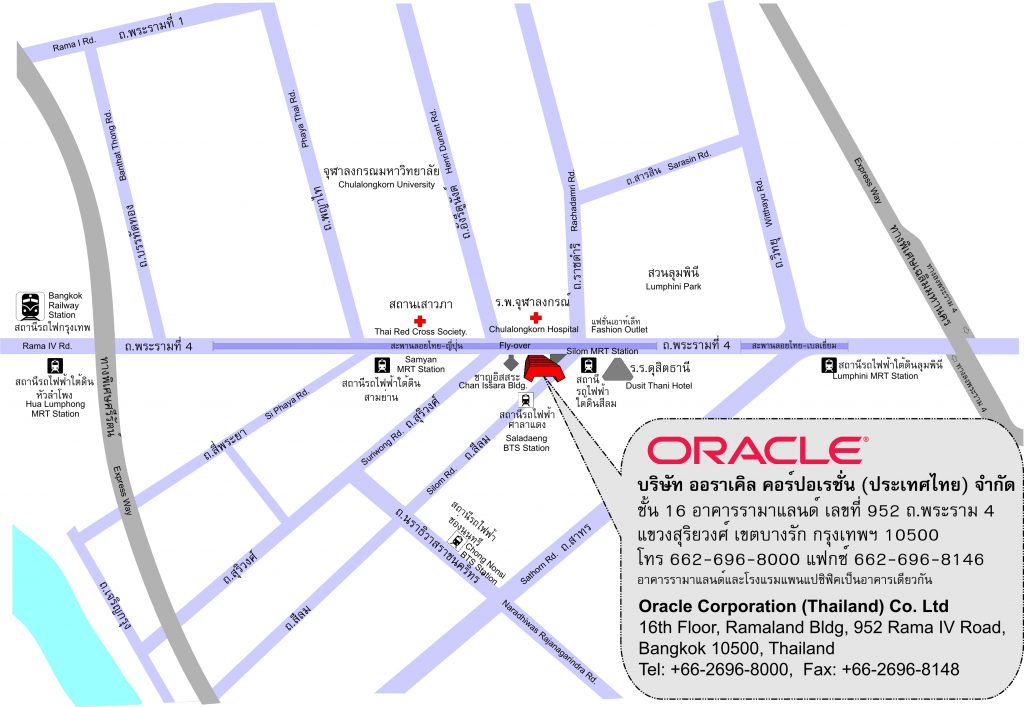สำนักวิทยบริการและเทคโนโลยีสารสนเทศ (สวส.) กำหนดฝึกอบรมหลักสูตร Instructor Training : Oracle Database 12C : Introduction to SQL Ed1.1 สำหรับอาจารย์ ระหว่างวันที่ 11-15 กรกฎาคม 2559 และ หลักสูตร Instructor training : Oracle Database 11g : Administration workshop I ระหว่างวันที่ 1-5 สิงหาคม 2559 สถานที่ฝึกอบรม Oracle University, ORACLE Thailand | 16th Fl., Ramaland Bld., 952 Rama IV Road, Suriyawongse, Bangrak | 10500 Bangkok. Phone : +66 2 6964705 │Fax: +66 2 6968145 Mobile : +6692 225 2634 Contact …Nathananyaphak S.N.R. (Nan) โดย สวส. เป็นผู้รับผิดชอบค่าใช้จ่ายในการลงทะเบียนเรียน และลงทะเบียนสอบให้แล้ว
รายชื่อผู้เข้าอบรมมีดังนี้
1. Mr. Pamok Rattanatraiyapibal
2. Mr. Sompoch Kulthararom
3. Mr. Chayakorn Potjamarnpimon
4. Mr. Nilamit Nilas
5. Ms. Narisara Nakmaetee
6. Ms. Sasithorn Chookaew
7. Mr. Narongrit Teeravech
แผนที่สถานที่ฝึกอบรม
รายละเอียดหลักสูตรการฝึกอบรม Oracle Database 12C : Introduction to SQL Ed1.1
| 11 July 2019 | Course Topics | |
| 8.30 – 12.00 | Introduction Course Objectives, Course Agenda and Appendixes Used in this Course Overview of Oracle Database 12c and Related Products Overview of relational database management concepts and terminologies Introduction to SQL and its development environments What is Oracle SQL Developer? Starting SQL*Plus from Oracle SQL Developer The Human Resource (HR) Schema Tables used in the Course |
|
| 12.00 – 13.00 | Lunch | |
| 13.00 – 16.30 | Retrieving Data using the SQL SELECT Statement Capabilities of the SELECT statement Arithmetic expressions and NULL values in the SELECT statement Column aliases Use of concatenation operator, literal character strings, alternative quote operator, and the DISTINCT keyword Use of the DESCRIBE command |
|
|
Course Topics | |
| 8.30 – 12.00 | Restricting and Sorting Data Limiting the Rows Rules of precedence for operators in an expression Substitution Variables Using the DEFINE and VERIFY command Controlling User Access System privileges Creating a role Object privileges Revoking object privileges |
|
| 12.00 – 13.00 | Lunch | |
| 13.00 – 16.30 | Using Single-Row Functions to Customize Output Describe the differences between single row and multiple row functions Manipulate strings with character function in the SELECT and WHERE clauses Manipulate numbers with the ROUND, TRUNC and MOD functions Perform arithmetic with date data Manipulate dates with the date functions Managing Data in Different Time Zones Working with CURRENT_DATE, CURRENT_TIMESTAMP and LOCALTIMESTAMP Working with INTERVAL data types |
|
|
Course Topics | |
| 8.30 – 12.00 | Using Conversion Functions and Conditional Expressions Describe implicit and explicit data type conversion Use the TO_CHAR, TO_NUMBER, and TO_DATE conversion functions Nest multiple functions Apply the NVL, NULLIF, and COALESCE functions to data Use conditional IF THEN ELSE logic in a SELECT statement Manipulating Data by Using Subqueries Using Subqueries to Manipulate Data Inserting by Using a Subquery as a Target Using the WITH CHECK OPTION Keyword on DML Statements Using Correlated Subqueries to Update and Delete rows |
|
| 12.00 – 13.00 | Lunch | |
| 13.00 – 16.30 | Reporting Aggregated Data Using the Group Functions Group Functions Creating Groups of Data Restricting Group Results Displaying Data from Multiple Tables Using Joins Introduction to JOINS Types of Joins Natural join Self-join Non equijoins OUTER join |
|
|
Course Topics | |
| 8.30 – 12.00 | Using Subqueries to Solve Queries Introduction to Subqueries Single Row Subqueries Multiple Row Subqueries Using the SET Operators Set Operators UNION and UNION ALL operator INTERSECT operator MINUS operator Matching the SELECT statements Using ORDER BY clause in set operations |
|
| 12.00 – 13.00 | Lunch | |
| 13.00 – 16.30 | Managing Tables using DML statements Data Manipulation Language Database Transactions Introduction to Data Definition Language Data Definition Language Introduction to Data Dictionary Views Introduction to Data Dictionary Describe the Data Dictionary Structure Using the Data Dictionary views Querying the Data Dictionary Views |
|
|
Course Topics | |
| 8.30 – 12.00 | Creating Sequences, Synonyms, Indexes Overview of sequences Overview of synonyms Overview of indexes Creating Views Overview of views Managing Schema Objects Managing constraints Creating and using temporary tables Creating and using external tables |
|
| 12.00 – 13.00 | Lunch | |
| 13.00 – 16.30 | Retrieving Data by Using Subqueries Retrieving Data by Using a Subquery as Source Working with Multiple-Column subqueries Using Scalar subqueries in SQL Correlated Subqueries Working with the WITH clause Manipulating Data Overview of the Explicit Default Feature Using multitable INSERTs Using the MERGE statement Performing flashback operations Tracking Changes in Data |


